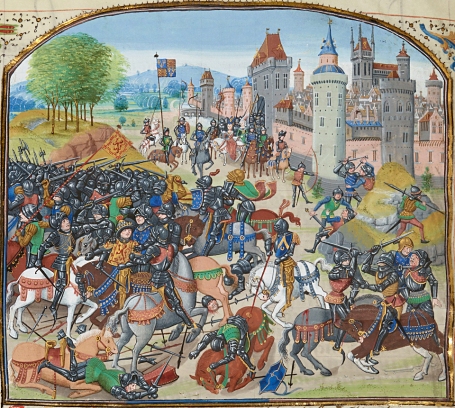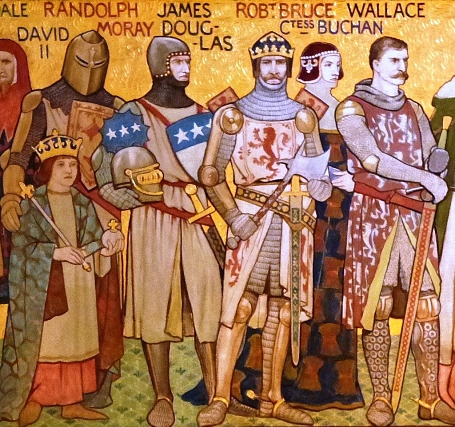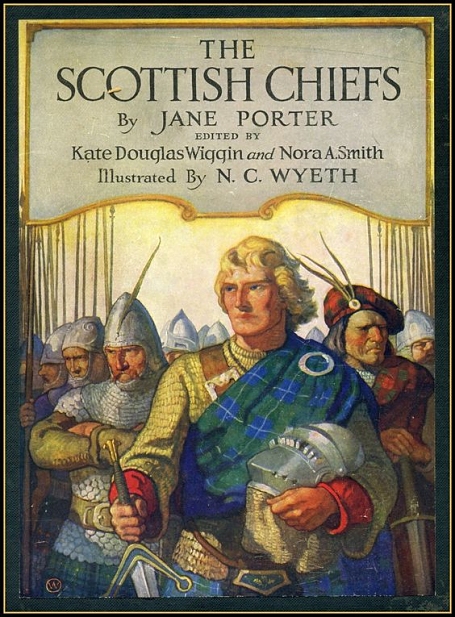The Life and Heroick Actions of the Renoun'd Sir William Wallace,
General and Governour of Scotland
by William Hamilton of Gilbertfield
Book VII, Chapter IV
How WALLACE laid Seige to Dundee, and gave Battle to Kirkingham Treasurer to King Edward, and the E. of Warran at Stirling Bridge
Wallace, his valiant Soldiers does oblige,
Most vig'rously the Castle to besiege.
Wisely disposes all, no Time is lost,
And to each Man assigns his proper Post.
By this Sir Aymer, that unnat'ral Foe,
In haste for England does prepare to go.
Like to Beshite himself with pannick Fear,
Packs up his Baggage, all his Goods and Gear.
Among the South'ron like a poor Exile
To lurk, and to abscond himself a While.
There Wallace Actions all he doth relate,
Which did oblige the English to regrate
Their sad Misfortunes, and unlucky Chance,
Which now had put their Measures to a Stance.
Edward to Scotland could not go that Time,
Yet still the more to aggravate his Crime:
He, Kirkingham his Treasurer does command,
And Earl Warran, with a Numerous Band
Of Horse and Foot on Scotland for to fall,
To worrie Wallace, and destroy up all.
This num'rous Host do march with all their Speed,
The Earl Patrick them receiv'd at Tweed.
Inveterate Malice who 'gainst Wallace bore,
As like a Rogue he always did before.
And to his Native Country now does strive,
To work all Mischief that he can contrive.
The English now a Muster do intend,
And find their Host full Sixty Thousand Men.
Then March they all straight unto Stirling Bridge,
And in their Way, the Castle do Besiege.
When of those News Wallace had got some taste,
He then indeed bestir'd himself in Haste.
A Captain plac'd, of Vigilance and Care,
For to Command the Siege was lying there.
Two Thousand good in Number they would be,
North-Country Men, and dwellers at Dundee.
Then march'd his Men, all cliver Young and tight
And in St. Johnstoun quarter'd that same Night.
At Sheriff-Moor, them up in Order drew,
Where narrowly he did them all review.
Then with brave Air, spoke Sir John the Graham,
The Glory of that noble ancient Name:
"Great Fates we have performed in the Field,
With smaller Force, and stronger Foes made yield."
"Who fight," said Wallace, "for just righteous Ends,
God unto them Assistance always sends.
Then, tho' the En'my were Ten Thousand more,
Let's up and beat them, as we've done before.
Near Stirling Bridge I purpose first to be,
There to contrive some subtile Jeopardie,
Wherein we may our South'ron Foes ensnare,
So soon as the Fat-lugged Lowns come there.
We'll keep the Bridge, with our true Men and stout
They'r not acquainted with the Way about."
Wallace sends Jop to tell that Tuesday next,
To fight the South'ron, was the Day prefixt.
On Saturday unto the Bridge they rode,
Which was well join'd, with good plain Boards and broad.
Watches he set about him ev'ry where,
That none might know what he was working there.
A cunning Carpenter, by Name John Wright,
He quickly calls and falls to work on Sight.
Caus'd saw the Boards immediately in Two,
By the mid Trest, that none might over goe.
On cornal Bands caus'd nail it very soon,
Then fill't with Clay, as nothing had been done.
The other End to stand, directeth there,
On wooden Rollers, with great Art and Care,
When one was out, that all the rest might fall.
The Carpenter below he caus'd withal,
In a closs Cradle cunningly to sit,
And loose the Pin when Wallace thought it fit.
Which by one Blast, he of a Horn would know,
Then to be sure, to let the Roller goe.
The ballad, The Life and Heroick Actions of the Renoun'd Sir William Wallace, General and Governour of Scotland, by William Hamilton of Gilbertfield, 1722, is in the public domain.

The Kingdom of England and the Kingdom of Scotland fought dozens of battles with each other. They fought typically over land, particularly Berwick-Upon-Tweed, and the Anglo-Scottish border frequently changed as a result. Read more at Wikipedia.

The First War of Scottish Independence was the initial chapter of engagements in a series of warring periods between English and Scottish forces lasting from the invasion by England in 1296 ... Read more at Wikipedia.

Digitized version of The Scottish Chiefs, by Jane Porter, a novelization published in 1921 by Charles Scribner's Sons, about William Wallace and the First Scottish War of Independence. Read online at archive.org.